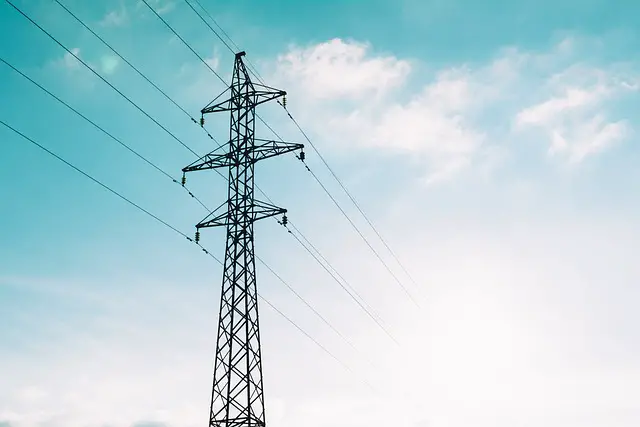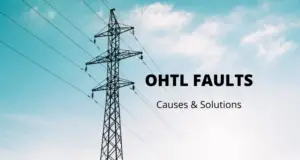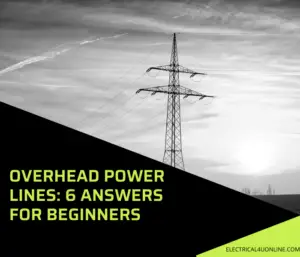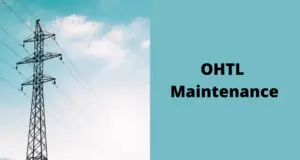Electricity is transmitted at high voltage to minimize power loss during transmission. Higher voltage reduces the current needed to deliver the same amount of power, and since power loss is proportional to the square of the current (Ploss = I2R) , this drastically decreases energy wasted as heat in the transmission lines.
High voltage also allows for smaller conductors, reduces costs, and enables efficient long-distance power delivery.
High-voltage transmission is a cornerstone of this process. This article explores why electricity is transmitted at high voltage, providing clear explanations and examples suited for engineering students, beginner engineers, and technicians.
Table of Contents
What Is Electrical Transmission?

Electrical transmission refers to the process of transporting electricity from power generation stations (like hydroelectric, thermal, or nuclear plants) to substations where it is distributed to homes, industries, and businesses. Transmission usually covers long distances, often hundreds or even thousands of miles.
Read also my article What are overhead transmission lines?
The Core Reason for High Voltage Transmission: Efficiency
The most fundamental reason for using high voltage in electrical transmission is to reduce power loss.
To understand why, let’s delve into the relationship between power, current, and resistance:
- Power Loss Formula:
Power lost due to heat in the transmission wires is given by Ploss =I2R, where:- I = Current in the wire
- R = Resistance of the wire
Since the power loss is proportional to the square of the current, even a small reduction in current leads to a significant decrease in power loss.
How Does High Voltage Reduce Current?
Electrical power transmitted (P) is the product of voltage (V) and current (I):
I = P/V
For a given power requirement, increasing the voltage allows the current to decrease. For example:
- To transmit 100 MW at 10,000 V:
I=P/V=100,000,000/10,000=10,000 A - To transmit the same 100 MW at 100,000 V:
I=100,000,000/100,000=1,000 A
A tenfold increase in voltage reduces the current tenfold, drastically cutting heat losses.
Benefits of Transmitting at High Voltage
- Reduced Power Loss
High voltage lowers current, and since Ploss = I2R, this means far less energy is wasted as heat. Over long distances, these losses could otherwise be substantial. - Smaller Conductors
Lower current requires thinner wires, reducing the weight and cost of transmission lines. For instance, overhead transmission lines carrying high-voltage electricity are usually made of lightweight materials like aluminum with steel cores for strength. - Cost Efficiency
Reducing power loss and material costs makes high-voltage transmission economically viable. Power companies can transmit large amounts of energy efficiently and affordably. - Enabling Long-Distance Transmission
With high voltage, electricity can travel over hundreds or thousands of miles with minimal energy loss. This is crucial for connecting remote generation stations, like wind farms or hydro-power plants, to urban areas where electricity demand is high. - Improved System Stability
High-voltage systems maintain better voltage regulation and reduce the chances of system instability or voltage drops over long distances.
Practical Examples in High-Voltage Transmission
- Transmission Line Voltages
Standard transmission line voltages vary across regions but typically include:- 110 kV (kilovolts)
- 220 kV
- 400 kV
- Ultra-high-voltage systems: 765 kV or higher
- Real-World Applications
A 500 kV transmission line can carry large amounts of power (e.g., 1,000 MW or more) over hundreds of miles while maintaining losses at manageable levels.
Challenges of High Voltage Transmission
While high voltage is advantageous, it also comes with challenges:
- Insulation Requirements
High voltages require robust insulation to prevent arcing and ensure safety. Transmission towers and cables are designed with materials and structures to withstand these voltages. - Safety Concerns
Working with high-voltage systems demands specialized training and safety protocols for technicians and engineers to avoid accidents. - Cost of Equipment
Transformers used to step up and step down voltage at substations are expensive and require significant investment.
How Is High Voltage Achieved and Managed?
- Step-Up Transformers
Electricity generated at power stations is usually at lower voltages (e.g., 11–25 kV). Transformers at the generation site step up this voltage to the high levels required for transmission. - Transmission Lines
The electricity flows through transmission lines, often strung on tall towers to keep them safe from interference and reduce energy loss further. - Step-Down Transformers
At the receiving end, substations use transformers to step down the voltage for distribution to consumers. Residential areas typically receive power at much lower voltages, such as 120 V or 240 V.
Why Not Transmit at Extremely High Voltages?
While higher voltage reduces losses, there is a practical limit to how high the voltage can go:
- Insulation Limits: Higher voltage requires advanced insulation, which becomes more expensive and complex at ultra-high voltages.
- Electrical Stress: Extremely high voltages create greater electrical stress on equipment and transmission lines, increasing maintenance costs.
- Cost vs. Benefit: At a certain point, the cost of increasing voltage outweighs the benefits of reduced losses.
The Future of High-Voltage Transmission
- Ultra-High-Voltage Direct Current (UHVDC)
- Direct current (DC) systems are becoming popular for very long-distance transmission because they have lower losses than alternating current (AC) systems.
- Example: China’s UHVDC systems operate at 1,100 kV, transmitting power over 2,000 miles.
- Renewable Energy Integration
High-voltage transmission is vital for integrating renewable energy sources like wind and solar into the grid. These sources are often located far from urban areas, requiring efficient long-distance transmission. - Smart Grids
Advanced technologies like smart grids are enhancing the efficiency of high-voltage transmission systems by optimizing energy flow and reducing downtime.
Conclusion
High-voltage transmission is a marvel of engineering that ensures electricity is delivered efficiently, reliably, and affordably over long distances. By stepping up the voltage, power companies minimize losses, reduce costs, and make modern power systems possible.
For electrical engineers and technicians, understanding the principles of high-voltage transmission is essential for designing, maintaining, and innovating within power systems.
Whether working on substations, transformers, or renewable energy projects, the concepts of high voltage will remain a cornerstone of your knowledge.
Don’t Leave Empty-Handed!
Install my Free Android App on Google Play:
Electrical Cables Most Common Tables “Cables Tables”
And, my Electrical Calculations App “Fast Electrical Calculator”
Discover more great content by subscribing to My channel
Looking to stay ahead of the game in the world of electrical engineering? Subscribe to my YouTube channel and gain access to exclusive content you won’t find anywhere else!
The staff I recommend
(Amazon Affiliate Links to products I believe are high quality):
- Economy 120 Volt/60Hz AC Power Source – Step-Down Voltage & Frequency Converters 1800W
- UNI-T Digital Multimeter Tester UT139C
- 50-Amp Extension Cord for RV “100ft”
- Voltage Stabilizer 110/220v
- Hair Dryer “best selling“
- TOSHIBA EM131A5C-BS Countertop Microwave Ovens
Disclaimer: This contains affiliate links to Amazon products. I may earn a commission for purchases made through these links.



